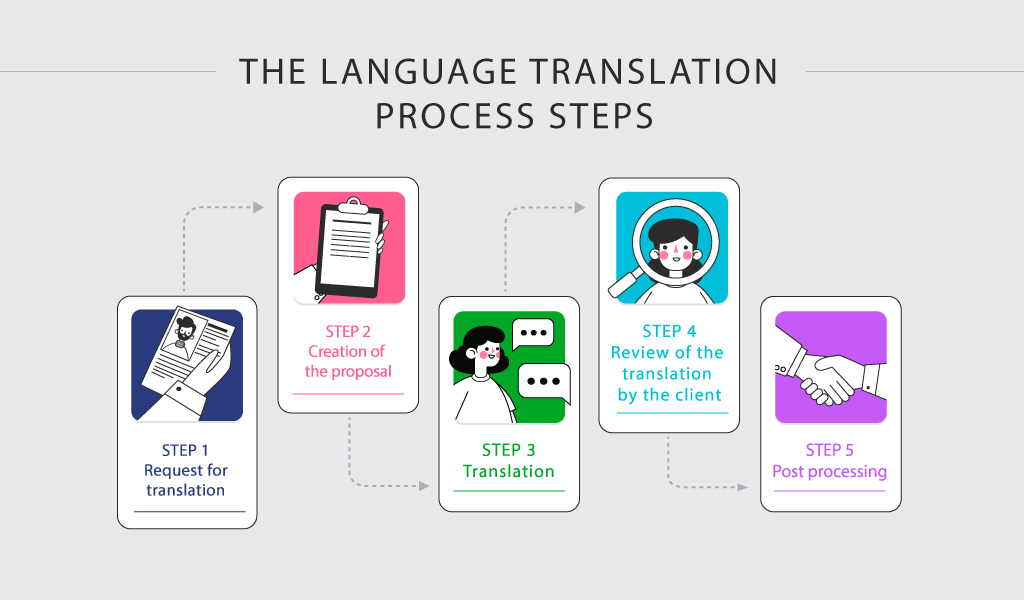What exactly is the difference between a translator and an interpreter? To many people, translation and interpretation sound like much the same thing. Looking at it this way, you might assume that translators could easily work as interpreters and vice versa – however, this is not true.
Yes, both professions work with languages, yet they fulfill different tasks, and a different skill set is needed to truly master each profession.
To start with, each one works in a different medium. While a translator translates a written source text into a written text in the target language, an interpreter translates the spoken word orally into another language.
But what’s the difference between a translator and an interpreter in detail? What types of interpreting and translating are there, and how can they be distinguished? Questions upon questions, to which we provide answers in this article. We talk about the similarities and differences between translation and interpretation, and tell you how each one is defined.
What is the difference between a translator and an interpreter?
Language interpreter definition
An interpreter translates the spoken word orally from a source language to a target language. This usually takes place on site, for example at a meeting, a conference or in court. But as with everything, there are exceptions – such as telephone interpreting.
What sets interpreters apart from translators is that they usually translate simultaneously, or with only a very small time delay. This is why an interpreter needs quick comprehension and has to be able to react spontaneously.
As well as interpreters who translate the spoken word orally, there are also sign language interpreters. As with spoken languages, there are many different sign languages. It is hard to know exactly how many different sign languages there are, but certainly more than a hundred.
Language translator definition
In contrast to an interpreter, a translator converts a written text from one language to another.
A translator analyses the source text and is able to do additional research, if needed, to make sure that the intent and the tone of voice of the original content is preserved in the translation. What’s more, translators can also use computer aided translation tools (CAT-Tools), such as translation memories.
Furthermore, there are many areas of translation where the translator needs special expertise in order to carry out a professional translation. Those areas include technical translation and medical translation, for example. In these cases the translator needs to be familiar with the terminology, while having specific background knowledge to make sure he or she understands the context.
As an international full–service agency for translation, localisation and international communication, EHLION works with highly skilled professionals around the globe. No matter whether you are looking for a translator or a professional interpreter, we have the right fit for you.
If you want to read more about the language industry as well as different cultures and languages, feel free to have a look at our EHLION Magazine. For everything else, our project managers at EHLION are happy to advise you on all questions regarding your translation project. Contact us for a free initial consultation.

Different types of translation services
In the translation industry there is a wide variety of translation services. One of the most broad distinctions can be made between general translation and translations that require expertise in a specific subject area, such as legal translation, medical translation or scientific translation.
General translations are characterized by the use of ordinary everyday language and vocabulary, and therefore don’t require any knowledge of special terminology. Clearly this is not the case for subject-specific domains such as IT and software translation. But there are other translation services out there as well. A few of the most important ones are:
- Literary translation
- Notarized translation
- Subtitling
- Commercial translation
Types of interpreting
Simultaneous interpreters usually work from a soundproof booth, for example during a conference. The interpreter speaks into a microphone and the audience is able to hear it through their headphones. The interpretation happens simultaneously.
Chuchotage, or whispered interpretation, is a less common variant of simultaneous interpreting. In contrast to simultaneous interpreting, it does not require any technical equipment, because the interpreter sits diagonally behind the person and interprets quietly for them.
Telephone interpreting can work in different ways. Either the conversation partners are in one room at one telephone and the interpreter is at the other end of the line, or the conversation partners are in different locations and connected via telephone, while the interpreter is connected with them via a conference call.
Consecutive interpreters take notes while someone is speaking and sum up the content after the speaker has finished. Because the interpretation takes up a certain amount of time, meetings and the like can also take longer when working with simultaneous interpreters.
Sign language interpreters either translate from spoken language to a sign language or from one sign language to another.
What is the difference between an interpreter and a translator and what are the similarities?
Now that we have taken a look at the definition of both professions, let’s delve a little deeper into what exactly makes the difference between translation and interpretation.
- Interpreters work with spoken communication, while translators work with written text.
- Interpreters often have to translate back and forth, e.g. at a meeting between two negotiating parties.
- Interpreters translate on spot without the help of the technology that is accessible to translators, like computer aided translation tools.
- Another difference between translation and interpretation is the level of accuracy. When it comes to translations, a very high level of accuracy is important, and everything in the source document must be precisely translated. Interpreters, on the other hand, focus on conveying the message on the spot in the best possible way. They often paraphrase things, instead of sticking exactly to the original wording. Therefore, a slightly lower degree of accuracy is acceptable.
- Interpreters need to be able to react quickly and spontaneously and have quick comprehension.
- Interpreters get paid per hour or per day, while translators usually get paid per word.
When we talk of the differences between translation and interpretation, we should also take a look at the similarities:
Interpreters and translators are both linguists who translate a message from a source language to a target language. They have an in-depth knowledge of the languages and the topics they are working with, as well as the culture of the country where the language is spoken.
Conclusion – interpreters and translators need a different skill set
The difference between a medical interpreter and a medical translator serves as a great example to illustrate the difference between translators and interpreters in general. While the first one is on site, e.g. in a hospital, translating back and forth between the patient and the doctor, the second one works at a computer in an office, translating medical texts.
In any case, no matter whether you need a translator or interpreter, you should make sure you are working with professionals who have an in-depth knowledge of their field, because nothing is worse than a message getting lost in translation.
EHLION works with qualified translators and interpreters and offers services in a variety of different languages. If you need advice about the next steps of your translation project or if you need to hire an interpreter, do not hesitate to contact us.









